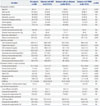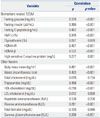Abstract
Purpose
Materials and Methods
Results
Figures and Tables
 | Fig. 1Prevalence of NAFLD according to the glucose tolerance status. (A) Subjects with NAFLD (CAP value ≥250 dB/m) increased according to the glucose tolerance status (31.9% in NGT; 47.0% in pre-diabetes; 57.6% in T2DM) (black bar). Subjects with moderate to severe NAFLD (CAP value ≥300 dB/m) increased according to the glucose tolerance status (9.7% in NGT; 15.3% in pre-diabetes; 33.3% in T2DM) (white bar). (B) Subjects with presence of NAFLD (diagnosed by ultrasonography) increased according to the glucose tolerance status (27.8% in NGT; 35.6% in pre-diabetes; 54.5% in T2DM) (black bar). Subjects with moderate to severe NAFLD (diagnosed by ultrasonography) increased according to the glucose tolerance status (6.9% in NGT; 8.4% in pre-diabetes; 22.7% in T2DM) (white bar). NAFLD, non-alcoholic fatty liver disease; CAP, controlled attenuation parameter; NGT, normal glucose tolerance; T2DM, type 2 diabetes mellitus. |
 | Fig. 2Severity of NAFLD according to the glucose tolerance status. (A) Subjects with T2DM had significantly higher median CAP values than those with NGT (265 dB/m vs. 231 dB/m, p<0.001) or pre-diabetes (265 dB/m vs. 245 dB/m, p=0.003). (B) In subjects with NAFLD (CAP value ≥250 dB/m), the median CAP value increased according to the glucose tolerance status: 259 dB/m, 278 dB/m, and 304 dB/m in NGT, pre-diabetes, and T2DM groups, respectively (comparison between groups: T2DM vs. NGT, p=0.006; T2DM vs. pre-diabetes, p=0.026; pre-diabetes vs. NGT, p=0.077). (C) In subjects with NAFLD (diagnosed by ultrasonography), the median CAP values increased according to the glucose tolerance status: 265 dB/m in NGT, 278 dB/m in pre-diabetes, and 302 dB/m in T2DM group (comparison between groups; T2DM vs. NGT, p=0.042; T2DM vs. pre-diabetes, p=0.047; pre-diabetes vs. NGT, p=0.484). NAFLD, non-alcoholic fatty liver disease; CAP, controlled attenuation parameter; T2DM, type 2 diabetes mellitus; NGT, normal glucose tolerance. |
 | Fig. 3HOMA-IR and fasting C-peptide level according to CAP values. (A) HOMA-IR was significantly higher in the group with CAP value ≥300 dB/m compared with the groups with CAP value of 250–300 or <250 dB/m (HOMA-IR, 3.00±1.99 vs. 1.64±1.04 vs. 1.63±2.59, respectively; p<0.001). (B) Subjects with CAP value >300 dB/m showed significantly higher fasting C-peptide than those with CAP value of 250–300 dB/m or <250 dB/m (fasting C-peptide, 2.71±0.95 ng/mL vs. 2.29±1.62 ng/mL vs. 1.97±0.88 ng/mL, respectively; p<0.001). HOMA-IR, homeostasis model assessment of insulin resistance; CAP, controlled attenuation parameter. |
Table 1
Baseline Characteristics

NS, not significant (p-value>0.05); NGT, normal glucose tolerance; T2DM, type 2 diabetes mellitus; HDL, high-density lipoprotein; LDL, low-density lipoprotein; HbA1c, hemoglobin A1c; HOMA-IR, homeostasis model assessment of insulin resistance; HOMA-β, homeostasis model assessment of beta cell function; CAP, controlled attenuation parameter.
Variables are expressed as mean±SD (range) or n (%).
Table 2
Multiple Logistic Regression Analyses of Factors Associated with T2DM

| Odd ratio (95% CI) | p value | |
|---|---|---|
| Age (yrs) | 1.07 (1.04-1.11) | <0.001 |
| CAP value (group 0 vs. 1) | 1.10 (0.59-2.16) | 0.374 |
| CAP value (group 0 vs. 2) | 2.83 (1.21-6.64) | 0.017 |
Models controlled for age, gender, BMI, waist circumference, triglyceride, HDL-cholesterol, and LSV.
T2DM, type 2 diabetes mellitus; BMI, body mass index; HDL, high-density lipoprotein; LSV, liver stiffness value; CI, confidence interval; CAP, controlled attenuation parameter.
Group 0, CAP value <250 dB/m; Group 1, 250 dB/m ≤CAP value <300 dB/m; Group 2, CAP value ≥300 dB/m.
Table 3
Correlations between CAP Values and Baseline Factors (n=340)





 PDF
PDF ePub
ePub Citation
Citation Print
Print


 XML Download
XML Download